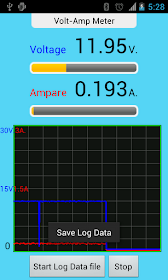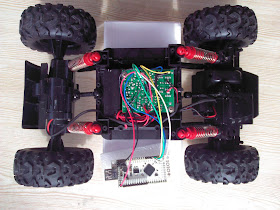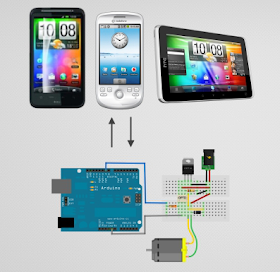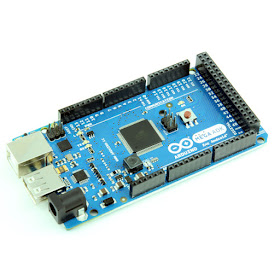-->
What
Is the Android ADK? (ภาษาไทย ด้านล่าง )
In May
2011, Google held its annual developer conference, the Google IO, to present
its newest technologies to approximately 5,000 attendees. In addition to
improvements in its already well-known technologies such as the Google APIs or
the core search technology, Google placed the focus on two major themes: Chrome
and Android. As always, the newest advances in the Android Platform were presented
and discussed, but what Google announced a bit later in the Android keynote was
a bit of a surprise: Google’s
first standard for Android devices to communicate with external hardware. The Android
Open Accessory Standard and the Accessory Development Kit (ADK) will be the key
for communicating with hardware and building external accessories for Android
devices. To encourage development, Google handed out ADK hardware packages to
interested attendees and showed some examples of ADK projects, such as a
treadmill which transmitted data to a connected Android device and a huge
tilt labyrinth, which could be controlled with an Android device. Shortly after
the event, the first DIY projects surfaced which already showed the great
potential of the ADK.
Since I
couldn’t attend the
event, I had no chance to get my hands on one of those kits; at the time, there
was only one distributor for the Google ADK boards and this distributor wasn’t prepared for such a big demand. That
didn’t stop me from
building an alternative myself and from experiencing the joy of this new field
in Android development. Over time, many more distributors have produced
derivatives of the original Google ADK boards, which are, for the most part,
cheaper and only provide the basics to get you started hacking your project
together.
You
probably just want to dive right in, but first you should learn about the
specifics of the ADK and set up your development environment. You wouldn’t build a house before you knew how to do
it or without having the proper tools, would you?
The
Accessory Development Kit (ADK) is basically a micro-controller development
board that adheres to the simple Open Accessory Standard Protocol created by
Google as a reference implementation. Although that could be any board
fulfilling the specification to be ADK compatible, most boards are based on the
Arduino design, which is an open hardware platform created in 2005. Those
boards are USB-enabled micro-controller boards based on the Arduino Mega2560
and the implementation of the Circuits@Home USB Host Shield. However, there are
other board designs known to be ADK compatible, such as PIC-based boards or
even plain USB host chip boards such as the VNCII by FTDI. Google decided to
build its reference kit upon the Arduino Mega2560 design and provided the
software and hardware resources as open source. This was a clever move because
the Arduino community has grown tremendously over the last years, enabling
designers, hobbyists, and average Joes to easily make their ideas come to life.
With the ever-growing communities of both factions of Android and Arduino enthusiasts, the ADK had a
pretty good start.
To
communicate with the hardware boards, an Android-enabled device needs to
fulfill certain criteria.
With Android Honeycomb version 3.1 and backported version 2.3.4, the necessary
software APIs were
introduced. However, the devices also have to ship with a suitable USB driver.
This driver enables general
USB functionality but, in particular, it enables the so-called accessory mode.
The accessory mode allows
an Android device that has no USB host capabilities to communicate with
external hardware,
which in turn acts as the USB host part.
The
specification of the Open Accessory Standard stipulates that the USB host has
to provide power for the
USB bus and can enumerate connected devices. The external device has to provide
500mA at 5V for
charging purposes of the Android device according to the USB 2.0 specification.
The ADK
also provides firmware for the development board which comes in the form of a
set of source
code files, libraries, and a demokit sketch,
which is the Arduino term for a project or source code file.
The firmware cares about the enumeration of the USB bus and finding a connected
device that is accessory
mode–compatible.
Google
also provides an example app for the Android device that easily accesses and
demonstrates the capabilities of the reference board and its sensors and
actuators. If you are working with a derivative board that doesn’t have the same variety of sensors, you
still can work with the example app, but you might want to strip the code down
to only the basic part of the communication.
When you
set up an ADK hardware project you are building a so-called Android
accessory. Your hardware project is an accessory
for the Android device such as, for example, a keyboard would be for a PC, with
the difference being that your accessory provides the power for the whole
system. Accessories need to support the already mentioned power supply for the
device and they must adhere to the Android accessory protocol. The protocol
dictates that the accessory follows four basic steps to establish a communication
to the Android device:
1. The
accessory is in wait state and tries to detect any connected devices.
2. The
accessory checks for accessory mode support of the device.
3. The
accessory tries to set the device in accessory mode if it is necessary.
4. If
the device supports the Android accessory protocol, the accessory establishes
the communication.
Google I/O 2011: Android Open Accessory API and Development Kit (ADK)
-->
Google I/O 2011: Android Open Accessory API and Development Kit (ADK)
Hardware
Development Boards
This
section will give you an overview of the variety of ADK-compatible development
boards that are currently on the market. Note that I can’t guarantee the completeness of this list
because the community advances at such a pace that new boards could pop up at
any time. I will concentrate on the most popular boards out there as of this
writing.
The
Google ADK Board
The
Google ADK is the reference kit presented at the Google IO in May 2011 and it
was the first board adhering to the Open Accessory Standard. The kit comes with
the ADK base board and a demo shield, as shown in Picture.
Google
ADK board and Demo Shield
The base
board contains the DC power connector, the USB connector (A-type receptacle) to
connect your phone or tablet to, and the micro USB connector (micro B-type
receptacle) to connect to your computer for programming and debugging purposes.
It has an ATmega2560 AVR chip from Atmel mounted on top, optimized for
C-compiled code, which makes it pretty fast and easily programmable instead of
comparable microcontrollers that have to be programmed in the assembler language.
The ATmega2560 has an internal flash memory of 256 Kbytes and an 8-bit CPU and
it operates at 16MHz. It provides 8KB of SRAM and 4KB of EEPROM. The IO ports
of the ATmega chip control 16 analog pins that provide 10 bits of input
resolution enabling analog-to-digital conversion of 1,024 different values.
They measure from ground to 5V by default. The chip has 54 digital pins with 14
of them being PWM (pulse width modulation) enabled to allow, for example,
dimming of LEDs or controlling servos. In the middle of the board is a reset
button to reset the program execution on the board. The board’s operating voltage is 5V. Although you
can power the board via a USB cable, you should consider using a power adapter
if you intend to control servos or drive motors.
The Demo
Shield is an additional board containing a broad
variety of different sensors and actuators. Shield is
an Arduino term for an extension board that can be put on top of an Arduino
base board. The connection is made via stackable pin headers. The IO pins of
the base board are mostly delegated to the pins of the shield so they can be
reused. However, certain shields might occupy pins to operate their sensors.
The demo shield itself is presoldered with male pin headers so no additional shields
can be stacked on top. This doesn’t
come as a surprise, since the shield uses most of the pins to let the base
board communicate with all of its sensors. Since the shield hides the reset
button of the base board, it contains one itself so that you can still make use
of the reset functionality. The most important parts, however, are the sensors
and actuators and there are a lot of them.
• One
analog joystick
• Three
buttons
• Three
RGB LEDs
• A
transistor functioning as a temperature sensor
• An
IC with an integrated photo diode for light sensing
• A capacitive touch area in the form of the
Android logo
• Two relays with screw terminals which can switch
external circuits with 24V up to 1A
• Three servo connectors
The Google ADK was originally produced by a
Japanese company for the Google IO. It can be ordered at www.rt-net.jp/shop/index.php?main_page=product_info&cPath=3_4&products_id=1. At a price of approximately $400 (not including
sales tax), it is one of the priciest boards out there
The Arduino ADK Board
The Arduino ADK is an ADK-compatible
base board from the makers of the Arduino series themselves. It is also based
on the ATmega2560 and only differs slightly from the Google reference board.
Arduino
ADK board.
The
Arduino ADK board also has a DC power connector and a USB connector (A-type
receptacle) mounted to connect to an Android device. The programming and
debugging connector, however, differs in being a standard USB connector (B-type
receptacle). The reset button is situated at the far end of the board and the
ATmega chip sits in the middle of the board. The IO pin layout is exactly the
same as inthe Google board and it has the same analog and digital pin
characteristics. The Arduino ADK, however, has two
ICSP 6-pin headers for In-Circuit Serial Programming (ICSP) of microchips.
Sharing the same pin layout and form factor, the Arduino ADK and the Google ADK
are compatible with the Demo Shield and other Arduino based shields.
The
Arduino ADK is made in Italy and can be ordered directly from the Arduino site
at http://store.arduino.cc/ww/index.php?main_page=product_info&cPath=11_12&products_id=144
or from one of its numerous distributors worldwide found at http://arduino.cc/en/Main/Buy.
At a
price of about $90 (not including possible shipping costs and taxes), it is way
more affordable than the Google ADK for the average hobbyist and hardware
hacker.
The
IOIO Board
The IOIO
(pronounced yo-yo) board is a PIC micro-controller–based development board developed by
Sparkfun Electronics before the announcement of the Open Accessory Standard.
Sparkfun
IOIO board.
The IOIO
board was designed to work with all Android devices with version 1.5 and above.
The original firmware design was targeted to work with the Android Debug Bridge
(ADB), which is normally used within the development process of an Android
application for debugging processes and for file system operations. After the
announcement of the Open Accessory Standard the IOIO was updated with a new
firmware to support both the Open Accessory Protocol and, as a fallback, the
ADB protocol to still support older devices. The firmware is still in beta as
of the time of writing this book. Since you need to update the firmware of the
board through a PIC programmer in order to make the board ADK compatible, it
might not be the perfect choice for an inexperienced tinkerer.
The
hardware specifics of the board are as follows. The IOIO has a form factor of
about a quarter of the size of a regular ADK-compatible board, which makes it
one of the smallest boards available. Nevertheless, it nearly keeps up with the
numerous IO pins of its big brothers. Many of the overall 48 IO pins have
several operating modes, which can make the pin assignments a bit confusing.
From the
48 IO pins, all pins can be used as general purpose input output ports.
Additionally, 16 of those pins can be used as analog inputs, 3 pairs of pins
can be used for I²C
communication, 1 pin can be used as a peripheral input, and 28 pins can be used
for peripheral inputs and outputs. Normally, the pins are 3.3V tolerant only,
but 22 pins are capable of tolerating 5V inputs and outputs. The I²C pins provide a fast and simple two-wire
interface to communicate with external integrated circuits such as sensor boards.
Apart
from the IO pins the board provides 3 Vin pins for power supply of the board.
On the bottom side of the board you can solder an additional JST connector to
connect a LiPo battery as the power supply. An operating voltage of 5V to 15V
should be supplied. Additionally, it has 3 pins for 3.3V output, 3 pins for 5V
output, and a 9 pin-area for ground.
The only
connector on this board is the required USB (A-type receptacle) connector. That
is because programming the hardware is not necessary, unlike for the other
ADK-compatible boards, which need C-compiled code for the hardware part. The
IOIO provides a firmware that implements all necessities.
You only
need to write the Android part by using a high-level API for easy pin access. One
interesting component of the board is a small trimmer potentiometer that can
limit the charging current of the Android device so that it won’t draw too much power when the board is
in battery mode. The IOIO has a PIC micro-controller chip instead of the AVR
chip most of the other boards use. The PIC24FJ256-DA206 chip operates at 32MHz,
has 256KB of programmable memory and 96KB of RAM.
The IOIO
was developed by Sparkfun Electronics and can be ordered via the Sparkfun web
site at www.sparkfun.com/products/10748 or
through one of its distributors. With a price of about $50 before shipping and
taxes, it is one of the cheapest boards out there but not one of the
friendliest to beginners.
The Seeeduino
ADK Board
The
Seeeduino ADK board , also derived from the ATmega board, looks
quite similar to the standard Arduino ADK board but, at second glance, it has
some nice extra features
Seeeduino
ADK board (image courtesy of Seeedstudio)
It has
56 digital IO pins with 14 of them being PWM capable, 16 analog input pins, and
1 ICSP header. The connectors on the board are of the same type as in the
original Google design. It has a DC power connector, a USB connector (A-type
receptacle), and a micro USB connector (micro B-type receptacle).
The
biggest difference with most other Atmega-like boards is that the Seeeduino ADK
board already ships with the MicroBridge firmware so that it works in ADK mode
with Android devices with OS version 2.3.4 and above and in ADB mode with
devices that have OS versions previous to version 2.3.4, much like the IOIO
does.
The
Seeeduino ADK board was developed by Seeedstudio and can be ordered at the
company’s web site at www.seeedstudio.com/depot/seeeduino-adk-main-board-p-846.html
or from one of their distributors.
It is
priced at $79 (before shipping and taxes), which makes it a very affordable but
powerful board.
More
ADK Possibilities
After
you have seen the most common boards with ADK support out there, you’ll probably wonder if that’s all there is. Although the Open
Accessory Standard is only about a year old, the number of boards already
available is incredible, with many still to come in this young but rapidly
evolving field of open source hardware. There are still plenty of other
possibilities for developing with the Open Accessory Standard. Some represent
pure DIY (do-it-yourself) approaches, while others are extensions for boards that
have been in use since before the ADK came out.
One early
approach was to port the ADK to the common Arduino Uno or Duemilanove. The only
thing you needed was an additional USB host shield to connect the Android
device to. I was one of those early DIY hackers who went in that direction. At
the time, it was the only affordable alternative to the original Google
reference board. Nowadays, I wouldn’t
recommend it; there are already perfect all-inone boards that don’t need additional shields, hacking, or
stripping of code. If you still want to use your regular Arduino there are a
lot of shops carrying USB host shields you can use:
• www.circuitsathome.com/products-page/arduino-shields/usb-host-shield-2-0-
for-arduino/
• www.sparkfun.com/products/9947
• www.dfrobot.com/index.php?route=product/product&filter_name=usb%20host&pro
duct_id=498
• http://emartee.com/product/42089/Arduino%20ADK%20Shield%20For%20Android
You may
have read about the possibility of enabling communication with Android devices
running an OS version lower than 2.3.4, which some boards provide. If also you
want to support that in your projects you should have a look at the microbridge
project that uses the ADB to establish the communication. Check the project
page for further details, at http://code.google.com/p/microbridge/.
Some of
the all-in-one boards also come bundled as a kit to let you tinker away with a
bunch of sensors. Those kits usually provide some of the same sensors that the
Google Demo Shield features.
Seeedstudio
also has a kit called Grove ADK Dash Kit. Like the Arduino kit, it also
provides an easy plug-and-play mechanism to start right away and it features a
broad set of sensors for all kinds of purposes. It is available at http://www.seeedstudio.com/depot/grove-adk-dash-kit-p-929.html.
If you
still want a kit based on the original Google design but importing the Japanese
original is not an option, you can also consider the following German clone,
which is nearly an exact clone with the minor improvement of providing a
gold-plated touch area that has better conductivity and hinders oxidation. It
is also a bit more affordable than the original and, depending on where you
live, the shipping costs may be lower. Check out www.troido.de/de/shoplsmallgbuy-androidstufflsmallg/
product/view/1/1 for
more information.
Which
Board Should You Use?
Now that
you have read about the variety of boards supporting the Open Accessory
Standard that are already out there you might wonder which board is the right
one for your own project. This is always a hard question, for which there is no
single answer. You should plan your project thoroughly ahead of time to analyze
which board fits best.
If you
are a beginner in the world of hardware development and ADK, you should stick
to the boards that are most commonly used out in the wild. As of this writing,
that would be the Google ADK board, which was given out to hundreds of
developers attending the Google IO 2011. If you are not one of the lucky ones to
have received one of these boards and your budget is pretty tight—which is usually the case—consider the standard Arduino ADK board.
Both of these boards are used in most hacker and maker projects I have seen so
far and they have a huge community built around them to help you if you are in
need.
Table gives you an
overview of the boards under discussion.
Comparison
of the Most Common ADK-Enabled Boards
ADK Boards
|
Google ADK
|
Arduino ADK
|
Seeeduino ADK
|
Sparkfun IOIO
|
Processor
|
ATmega2560
|
ATmega2560
|
ATmega2560
|
PIC24FJ256
|
CPU clock speed
|
16 MHz
|
16 MHz
|
16 MHz
|
32 MHz
|
Flash memory
|
256 Kbytes
|
256 Kbytes
|
256 Kbytes
|
256 Kbytes
|
RAM
|
8 Kbytes
|
8 Kbytes
|
8 Kbytes
|
96 Kbytes
|
Digital IO pins
|
54 (14 PWM)
|
54 (14 PWM)
|
54 (14 PWM)
|
48 (28 PWM)
|
Analog input pins
|
16
|
16
|
16
|
16
|
Input voltage
|
voltage 5.5V - 16V
|
voltage 5.5V - 16V
|
voltage 5.5V - 16V
|
5V - 15V
|
Connectors
|
DC
power
USB
A-type
USB micro B-type
|
DC
power
USB
A-type
USB B-type
|
DC
power
USB
A-type
USB micro B-type
|
USB
A-type
|
|
|
|
|
|
In Thai Language
ในเดือนพฤษภาคม 2011, Google จัดประชุมนักพัฒนาประจำปีของ Google IO, ที่จะนำเสนอเทคโนโลยีใหม่ล่าสุดที่จะเข้าร่วมประชุม ผู้ประชุมประมาณ 5,000 คน นอกจากการปรับปรุงในเทคโนโลยีของแล้วที่รู้จักกันดีเช่น Google APIs หรือเทคโนโลยีการค้นหาข้อมูล Google ได้วางเนื้อหาเจาะจงไปที่สองประเด็นหลัก: Chrome และ Android และเช่นเทคโนโลยีใหม่ล่าสุดในแพลตฟอร์ม Android จะถูกนำเสนอและพูดคุยความคิดเห็น แต่สิ่งที่กูเกิลประกาศต่อไปในประเด็นสำคัญของ Android เป็นเรื่องใหม่คือ: มาตรฐานของ Google สำหรับอุปกรณ์ Android ในการสื่อสารกับฮาร์ดแวร์ภายนอก คือ Android Open Accessory Standard และ Accessory Development Kit (ADK) จะเป็นกุญแจสำคัญสำหรับการสื่อสารกับฮาร์ดแวร์และสร้างอุปกรณ์ภายนอกกับอุปกรณ์ Android เพื่อเป็นการส่งเสริมให้การพัฒนาของ Google ได้ออกแบบแพคเกจฮาร์ดแวร์ ADK เพื่อที่ให้ผู้เข้าร่วมประชุมเป็นที่สนใจและแสดงให้เห็น Demo บางส่วนของโครงการ ADK เช่น ลู่วิ่งที่ส่งข้อมูลไปยังอุปกรณ์ของ Android และ
เขาเกมวงกตขนาดใหญ่ที่สามารถควบคุมด้วยอุปกรณ์ Android หลังจากนั้นไม่นานโครงการ DIY ก็เกิดขึ้นมาซึ่งแสดงให้เห็นถึงการมีศักยภาพที่ดีของ ADK
เนื่องจากผมไม่สามารถเข้าร่วมงาน จึงไม่ได้รับพัฒนาเหล่านั้น มีเพียงผู้ผลิตเดียวเท่านั้นสำหรับ Google ADK Board และผู้ผลิตก็ไม่ได้เตรียมไว้ สำหรับผู้ที่ต้องการจำนวนมากๆ แต่นั่นก็ไม่ได้หยุดผมจากการสนใจที่จะพัฒนาสร้างทางเลือกใหม่ให้ตัวเองและพัฒนาในระบบนี้ให้ได้ในรูปแบบใหม่ๆ เมื่อเวลาผ่านไปผลิตรายอื่น ๆ ก็เกิดขึ้นอีกมากมายได้มีการพัฒนาจาก Google ADK Board ให้มีราคาถูกและใช้งานได้ในการเริ่มพัฒนาโครงการของคุณ
การเริ่มพัฒนาให้ถูกทาง แต่แรกที่คุณควรเรียนรู้เกี่ยวกับข้อมูลเฉพาะของ ADK และติดตั้งส่วนการพัฒนาต่างๆของคุณ คุณคงจะไม่สร้างบ้านก่อนที่คุณจะรู้วิธีสร้าง และมีเครื่องไม้เครื่องมือที่เหมาะสมใช่ไหม?
Accessory Development Kit (ADK) เป็นระบบไมโครคอนโทรลเลอร์ที่ใช้ Open Accessory Standard Protocol ที่สร้างขึ้นโดย Google ไม่ว่าบอร์ดของผู้ผลิตอื่นๆ ก็เป็นไปตามข้อกำหนดของ ADK แต่ ADK Board ส่วนใหญ่จะออกแบบด้วย Arduino ซึ่งเป็นแพลตฟอร์มฮาร์ดแวร์ที่ถูกสร้างขึ้นในปี 2005 บอร์ดที่มีระบบ USB ก็จะใช้เป็นรุ่น Arduino Mega2560 และใช้ Circuits@Home USB Host Shield แต่ก็มี ADK Board ที่ออกแบบด้วย micro controller ตระกูลอื่น เช่น PIC-based ADK Board หรือแม้แต่ USB Host Chip เช่น VNCII โดย FTDI
Google ตัดสินใจที่จะสร้างชุดพัฒนาต้นแบบ โดยใช้ Arduino Mega2560 และให้ข้อมูลซอฟต์แวร์และฮาร์ดแวร์ที่เป็นแบบโอเพนซอร์ส เป็นกลยุทธที่ชาญฉลาดเพราะทำให้ การใช้งาน Arduino มีการเติบโตอย่างมากในช่วงหลายปีที่ผ่านมาทำให้นักออกแบบ, ผู้เล่นเป็นงานอดิเรก hobbyists ใช้ได้อย่างง่ายดาย ทำให้ความคิดที่จะนำมาใช้งานในชีวิตประจำวันมากมาย เป็นการเพิ่มผู้ใช้งาน ทั้งสองฝ่าย Android และ Arduino
ADK จึงมีจุดเริ่มต้นด้วยดี
Android Developer
http://androiddevelopersthai.blogspot.com/
Android example code
http://androidcodeexample.blogspot.com/































